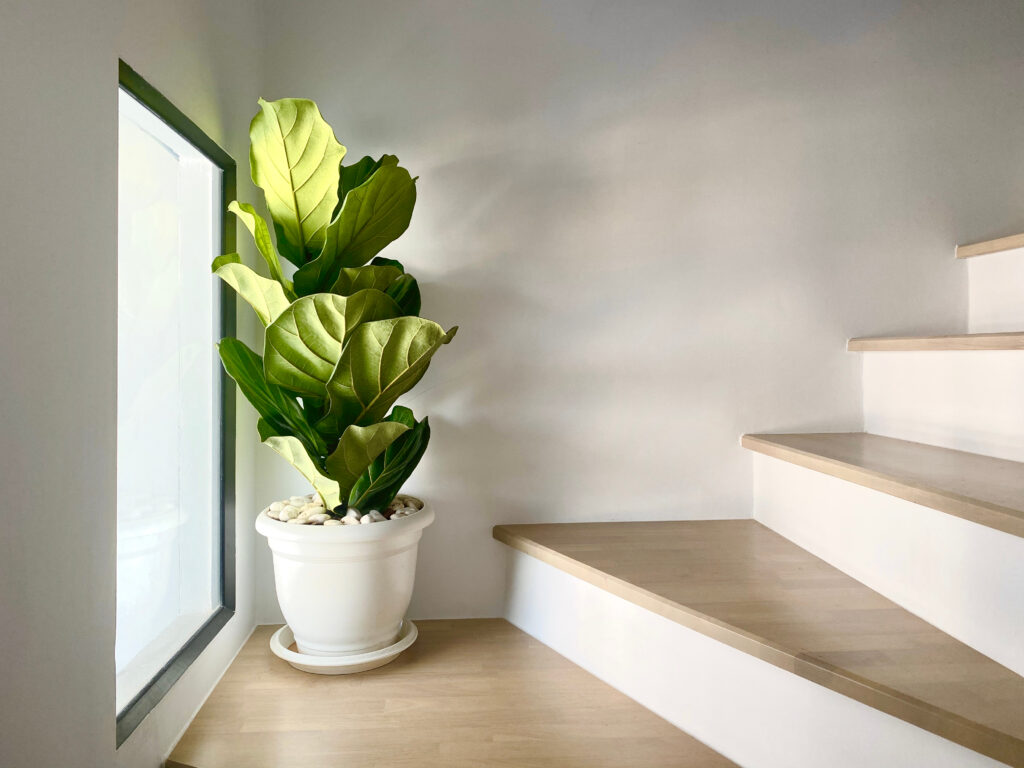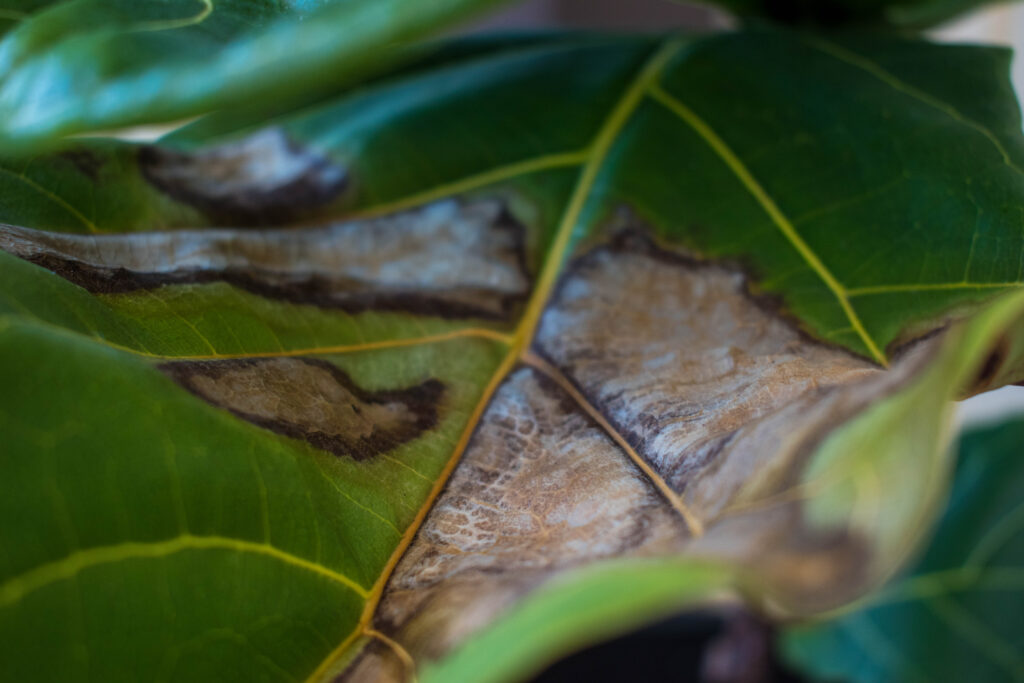Fiddle leaf figs are large, glossy rainforest plants from tropical Africa. In the wild, they grow near large trees in a warm and humid environment. This means they get lots of sustained but indirect light from the African sun. This already tells us a lot about the plant’s unique light requirements! Discover many tips on fiddle leaf fig light requirements in the complete guide below.
How Much Light Does a Fiddle Leaf Fig Need?
Fiddle leaf figs receive lots of light in their native African environment, but rainforest trees filter it. Fiddlers generally need around 6-8 hours of sunlight a day, but they can cope with less and tolerate more if they are looked after well.

Fiddlers generally need around 6-8 hours of sunlight a day, but they can cope with less and tolerate more if they are looked after well.
©Kowit Phatipreechakul/Shutterstock.com
Why Do Plants Need Light?
Plants are autotrophs, which means they create their own food. In order to create it, they need certain ingredients: nutrients, sunlight, water, and carbon dioxide. Using this combination, they perform photosynthesis, which is similar to animals eating, drinking, and breathing. When plants perform photosynthesis, oxygen is a by-product, which is important for human and animal life.
If one or more of the ingredients are missing, they can’t photosynthesize properly and suffer as a result.
The sun is a plant’s main light source, but some growers harness artificial horticultural lights to extend the growing day or grow crops out of season.
Even if a fiddle-leaf fig has enough water and carbon dioxide, it can’t use them to make its food without light. That’s why getting the right light requirements is so important.
Can a Fiddle Leaf Fig Cope With Low Light?
Plants are tough and want to live, so a fiddle-leaf fig can cope with low light, but it won’t thrive. However, they are more low-light tolerant than plants like succulents, which need a lot of consistently bright light to grow.

The sun is a plant’s main light source, and some growers harness artificial horticultural lights.
©NARANAT STUDIO/Shutterstock.com
How Do I Know If It’s Getting Enough?
If a fiddle leaf fig gets enough light, it will look glossy, healthy, deep to mid-green, and will grow around a foot each year. Indoors, it’ll top out at ten feet, but they can reach the lofty heights of 50-60 feet outdoors.
If light requirements aren’t met, a fiddle leaf fig will show one or all of these issues.
Leggy: When a plant is leggy, it grows vertically with a large space between each branch or leaf. It’ll look stretched. It’s because it’s growing upwards quickly to try and find more light. Fiddlers with enough light exposure look bushy, with only a few inches between each branch.
Poor color: Insufficient light leads to pale or intensely dark foliage.
Brown or damaged leaves: When fiddlers can’t photosynthesize and make their food, they become weak, which shows up in the foliage. As well as poor color, leaves may turn brown or have rough brown patches all over the foliage and stem.
Dropped leaves: To try and survive, a fiddler will drop its foliage and concentrate its food resources on its cells. It’ll shed leaves to cut down food requirements.
Failure to thrive: Without sufficient light, a fiddler just won’t put on its expected foot of yearly growth.
Pests and diseases: Fiddlers in poor health are likelier to suffer from pests or diseases. If mildew keeps appearing, or spider mites and aphids consistently take their toll, it could be that there’s just not enough light for the fiddler to fight them off.

When fiddlers can’t photosynthesize, leaves may turn brown or have rough brown patches all over the foliage and stem.
©Kara Knight/Shutterstock.com
Best Place for a Fiddle Leaf Fig Indoors
The best place for an indoor fiddle leaf fig is a spot that receives plenty of indirect light every day for 6-8 hours. This is often near a window but not in direct sunlight.
Windowpane glass magnifies the sun’s rays, which can burn them when they fall on a fiddler’s large glossy foliage. Leaf scorch manifests as small or large rough brown or black patches. It’s not reversible, so it’s best to ensure your fiddler doesn’t receive full sun in the first instance.
An ideal position receives morning or afternoon light that is unobstructed by outdoor plants or buildings. Place your fiddler just shy of the direct rays.
It’s important to reassess an indoor fiddler’s light requirements when the seasons change. In fall, less light can mean it doesn’t receive enough to photosynthesize well; in summer, it may scorch in direct sun.
You could consider LED horticultural lights if you can’t find a spot with enough natural light. Domestic light bulbs won’t work, and specialist growing lights are much more affordable than a few years ago.
Fiddle Leaf Figs: Rotation
One aspect of light requirements that fiddler owners often forget about is rotation. If one side of your fiddle leaf fig always gets light, it’ll grow faster than the shaded side. To achieve healthy growth and even color, rotate your plant a quarter turn each week.

To achieve healthy growth and even color, rotate your plant a quarter turn each week.
©Rawpixel.com/Shutterstock.com
Best Place for a Fiddle Leaf Fig Outdoors
Outdoor fiddle leaf figs can grow to epic heights of 50-60 feet. The best growing zones are USDA 9-11 because they mimic a fiddler’s warm native rainforest habitat.
When choosing the best outdoor spot, consider how much light your fig will receive throughout the year. Will it receive 6-8 hours in winter when the sun is lower and might be obstructed by buildings or other plants?
If in doubt, a sunnier spot is best. Outdoor figs can tolerate direct sunlight because the glass does not magnify it, but they do need acclimatizing first. More on that below.
In very hot zones, a spot with shade from the midday or late afternoon sun is best. In their native habitat, towering rainforest trees protect them from the full sun.
If you aren’t sure, start your fiddler off in a container so you can move it around and be sure of the best position before finally planting it in the soil.
How to Acclimatise a Fiddle Leaf Fig Outside
Fiddle leaf figs are grown indoors, often under artificial light. This means they have a nasty shock if you plant them outdoors in full sun. It’s best to take it slow and acclimatize the fiddler so it doesn’t drop all its leaves or receive a nasty sunburn.
New outdoor fiddlers should be put in the sun for an extra hour every few days to get used to the sunlight. After a few weeks, they could be hardy enough for a final position, but take a look at the foliage first. If it’s pale, spotted, or damaged, take it slow and ensure they get plenty of water.
A Guide to Fixing Insufficient Light Problems
Think your fiddle leaf fig isn’t getting enough light? Here’s how you can fix it and grow a glossy, luscious plant.
Indoor Light Fixes
Fiddlers without insufficient light have to move. This might be more towards the window or another position entirely. Be prepared for leaf drop when repositioning a fiddle leaf fig. They are notoriously grumpy plants and may well throw leaves down in protest. Don’t worry. If the new position is right, it’ll grow back its foliage and more.
To help it through, mist the leaves to increase rainforest-style humidity, ensure it’s getting enough water and fertilizer, and ensure no drafts or radiators are nearby.
You can also consider indoor horticultural growing lights.
Outdoor Light Fixes
Outdoor fiddlers in the ground really don’t like being moved because transporting them can damage their roots. Firstly, try cutting back any surrounding vegetation that’s creating shade. If that’s not enough, choose a new spot and dig up your fiddler, being very careful around its roots. Moving the root ball intact with plenty of soil still attached is the best way.
Fiddlers in a container are much easier to move around, but be prepared for the grumpy leaf drop.
Recap: A Complete Guide to Fiddle-Leaf Fig Light Requirements
Fiddle leaf figs’ light requirements are one of the most important aspects of their care. Indoors, they need lots of indirect sunlight to thrive. It’s also important to consider seasonal changes that impact how much light falls on its foliage.
Outdoor fiddlers need lots of light, too, but midday sun in zones 10-11 could prove too hot, so shade is required. Conversely, if surrounding vegetation grows too large, it could shade out light and mean not enough reaches your fiddle-leaf fig.
The best way to ensure a fiddle leaf fig gets enough light is to reassess it each season. If it shows any signs of poor growth, disease, or discoloration, consider whether it would be better off in a different spot. Luckily, light issues are fixable.

The best way to ensure a fiddle leaf fig gets enough light is to reassess it each season.
©Rachata Teyparsit/Shutterstock.com
The photo featured at the top of this post is © NARANAT STUDIO/Shutterstock.com
Thank you for reading! Have some feedback for us? Contact the AZ Animals editorial team.






